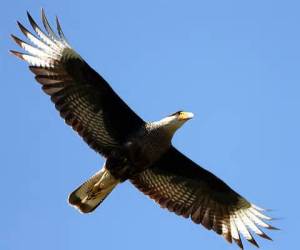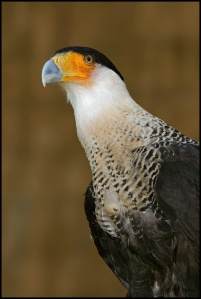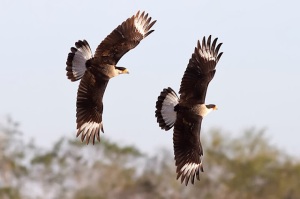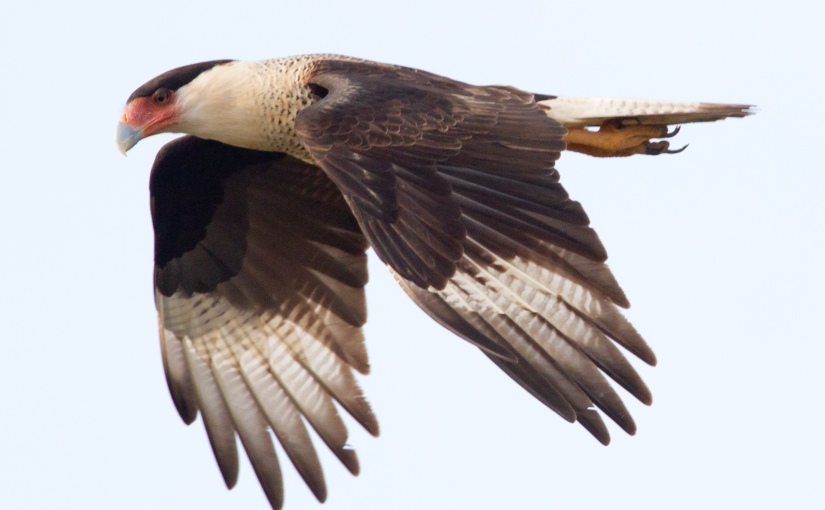For Lauren, who loved all Florida birds

In Florida, the last week in January was Crested Caracara week. I declared this week myself because I wanted to discover some of these magnificent birds. My Sibley Field Guide to Birds of Eastern North America indicates you can find them in the central part of southern Florida. Also in some parts of Texas, and definitely in Mexico, where they appear on the national flag, sitting on a cactus, holding a snake. (Some say it’s an eagle, but I prefer the caracara interpretation.)

A crested caracara is big–almost as big as a vulture, black and white, and has long yellow legs. Its bill is blue and it has a patch of featherless skin just behind the bill. This patch of skin is like a mood ring, changing from pale yellow to bright orange, depending on whether or not the bird is relaxed or stressed. As I understand it, if this patch of skin is pale the bird may be resting, orange it’s under threat, or eating, or choosing a mate. Something exciting. Pink skin behind the bill means the bird is a juvenile. Completing the crested caracara’s appearance is a top knot of black feathers that looks sort of like a toupee. A bad one. To see a caracara is to love one.

My friend France and I went to Felda, Florida, about 45 minutes east of Ft. Myers. There, the land is orange trees and pasture and not much else. But sure enough, there were some caracaras sitting in a tall Australian pine tree just waiting for their week in the sun.
Usually caracaras hang out with vultures. Even though they are classed as falcons, they prefer carrion. Dead stuff, although they will eat anything they can catch or steal. Admittedly, I had seen caracaras before, feeding or waiting for something to be killed on central Florida roads. However, these sightings usually occurred when we were flying along at high speeds, tailed by trucks. I would yell, causing the husband-driver apoplexy, and by the time we could turn around, the caracaras had disappeared.
But today the crested caracaras were just sitting…until about 9:30 am or so, and then the show began. Pairs of them, and they are big birds, would take to the sky and fly together, almost wing tip to wing tip or stacked up vertically. It looked to me that they were flying just to see if they were coordinated enough to join up, if you get my drift. Sometimes they did the talons locked thing and took an awkward tumble or two toward the ground. They also made noise, a chucking sound, not pretty, but effective, at least for them.

After the sky show, they grabbed adjacent fence posts and rested. For longer than they flew around. It was not a magnificent aerial show, like say, eagles, but we humans were thrilled. It was time for bird love among the caracara, and we got to witness it.
If you are not a bird nerd, like me, you probably don’t know how birds actually mate. It’s called a cloacal kiss, and sometimes it takes less that a second. I’m not making this up. Birds don’t need any outside appendages like penises slowing down the flight, so it’s all tucked inside. While they are sitting somewhere, the male gets on top from behind and the female adjusts her position and they rub their cloacal openings. Sperm goes in,finds an egg and this results in actual eggs–fertilized, laid, incubated and hatched. The cloacal opening is used for all things–defecation and egg laying too. A neat and tidy system.

Sorry for the lecture on bird sex, the point is I can only hope that these caracaras nest and raise young so there will be more of these wonderful birds in Central Florida, where they are listed as endangered. And we can celebrate Crested Caracara Week again.
Special thanks to my friend and extraordinary birder France Paulsen and my talented husband, John Swank for some of these wonderful pictures. Their blogs: johnphotoblog.wordpress.com and birdstring.blogspot.com
(Other photographs were obtained on the internet and the photographers are named, thanks to Google Image Finder)
